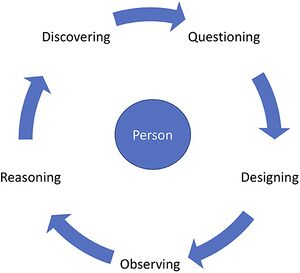Getting started with personal science
- This page is about how to get started with your own personal science project. See Getting started with wiki syntax for details on how to use this wiki.
Getting started with personal science can feel intimidating as there are a lot of components to consider when trying to answer personal questions. This page tries to accumulate best practices and advice to help both newcomers and experienced personal scientists in thinking and designing their personal science efforts. It is based on years of experience of personal scientists and is a living guide, which means that you are invited to edit and improve this article as well.
A framework for Personal Science
In 2020, Gary Wolf and Martijn De Groot published an article presenting a conceptual framework for personal science[1], which consists of five stages: "Questioning", "Designing", "Observing", "Reasoning" and "Discovering". Since then, this framework has been simplified in some places. Both the book "Personal Science" as well as the Quantified Self "Get Started" guide[2] have removed the "Designing" stage from their advice.
This simplification was done as it can be very hard to differentiate between "design" and "observation" as they often relate to each other and changes in the project design are often related to initial observations.
Questioning
The step of questioning requires thinking about why one wants to do a self-research project in the first place. It is also one of the most important steps in deciding to do a project, as it will inform all other decisions (e.g. on which methods or tools to use, which things to track etc.). There can be many reasons to start a self-research projects. Some common reasons that have motivated people in the past include,
- Increasing self-awareness (e.g. when/where is particular thing happening to me)
- Learning about the frequency or intensity of things (e.g. of symptoms like pain or allergies or changes in mood, weight or other phenomena)
- Improving ones health or well-being, e.g. when having a chronic condition
- Making progress in physical training or sports, trying to recover from an injury
- Creatively expressing oneself through data and visualizations
- Wanting to learn a new skill
Framing a question
A good starting point for a personal science project can be to just write down a small bit on the goals and questions one is trying to answer with this. There is no "right" way for where or how to write this. One can write a few sentences in a physical notebook, somewhere in a digital notes tool or even create a small project page in this wiki (it can be as little as in this example). One doesn't have to share this brainstorming step with others, but by making it publicly available and discussing it with others one gets the opportunity to get feedback and advice early on.
In the context of health-related questions, it might also be better to start from exploring ones own experiences rather than trying to dive into trying to find causes right from the start. Collecting data to conclusively "proof" a certain diagnosis is a very high bar to take and can be an overwhelming task to start out in a personal science project. Instead, it might be worth focusing on questions like "How bad are my symptoms?", "How often do they occur?", "What helps to improve my condition?". Framing questions this way might make it easier to make observations and reason about the records one collects.
Observing
Once one has decided on what kind of questions one would like to pursue, it is time to think about how to answer it. Virtually all self-research projects require making deliberate observations. This requires selecting some parameters that one wants to pay special attention to to keep track of them. There are some things to consider when selecting what to observe.
- Relevancy: Does observing this offer insights into what I really care about?
- Convenience: Can I collect these observations easily and consistently?
- Trustworthiness: Am I confident in the measurements?
On some level these things are interrelated. For example, using a digital tool such as a wearable device can be a very convenient way to passively collect data such as daily step counts. But is measuring steps really relevant for the question at hand? And how confident can one be in that the step counts are correct? In many cases it might be necessary to decide on trade-offs between these points.
Another good rule of thumb for observations is that the events or phenomena that one plans to record should be noticeable, variable and distinct as this will help facilitate recording the observations and reasoning about them later on. Having noticeable events helps recording the data, in particular when doing so manually by entering data by hand into a notebook, spreadsheet or mobile app (e.g. symptom recordings). Variability is important, as events that never change in frequency or intensity or any other dimension will not provide any insights (see relevancy above). Lastly, having distinct events is important to be able to correctly record observations as a lack of distinctiveness makes it hard to "correctly" count how often a thing happens.
Using proxies
Many things one might want to observe can be either hard to quantify (e.g. the abstract idea of "fitness") or hard to consistently observe because it would be too challenging to collect the "ideal" data over a period time. In such cases one can try to replace the direct observation through a proxy measurement that is closer to the ideal conditions outlined above. For example, instead of measuring "fitness" one could track physiological values such as Heart Rate Variability or how fast one runs, how many weights lifted etc.
How to observe and record
References
- ↑ Wolf GI and De Groot M (2020) A Conceptual Framework for Personal Science. Front. Comput. Sci. 2:21. doi: 10.3389/fcomp.2020.00021
- ↑ https://quantifiedself.com/get-started/
